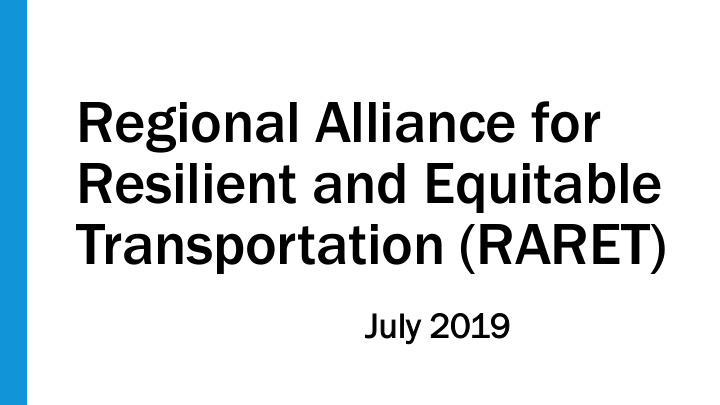



Regional Alliance for Resilient and Equitable Transportation (RARET) Jul July 2019
Welcome! • Welcome & Introductions • Announcements
RARET Logo Options 1 2 3 4
Briefing: Regional Emergency Transportation Coordination Workshop • 30 regional attendees (40% non- RARET members) • Discussed transportation coordination opportunities to support populations with access and functional needs in an emergency • Outcomes & Next Steps
Briefing: Regional Emergency Transportation Coordination Workshop
Update: Road Closure Repository Tool http://raret.surge.sh/roadalerts Succe cesses: Conducted Stakeholder interviews with regional Public Works contacts Piloted functional tool for transportation providers Next Steps Document Lessons Learned Improve Accessibility
Briefing: 2017-2019 Biennium in Review Highlights: • Coaliti tion n Buildi ding ng: Conducted bimonthly RARET meetings with an average of 13 attendees, increased from 11 average attendees per meeting in 2017-2018. • Inform rmati tion n Sharing ng: Presented on the RARET workgroup at conferences, community meetings, and coalitions, reaching over 200 individuals. • Trainin ing and Educati tion: Trained 61 critical transportation staff (Hopelink) and 12 transportation providers on emergency preparedness, business continuity. • Coordinati tion: Participated in King County Emergency Response (2/2019) and Northwest Healthcare Response Network Coalition Surge Test (6/2019).
Discussion: RARET Organizational Structure Existi ting Struct ctur ure: e: During the 2017-2019 Biennium, RARET adopted a co-chair structure with goal of having co-chairs representing Emergency Management and Transportation. Propose sed d Struct ctur ure: e: Establish a Steering Committee to better reflect the regional distribution and diverse perspectives of RARET workgroup stakeholders.
Discussion: RARET Organizational Structure The Steering Committee will be responsible for: Monitoring progress of the RARET Action Plan Guiding the development of RARET bimonthly meeting agendas Reviewing and approving changes made to project schedules, scope, and goals Reviewing and suggesting solutions for the issues critical to project success in the absence of a project taskforce. Making strategic decisions regarding the prioritization of project deliverables and approving interim deliverables.
Discussion: RARET Organizational Structure • Local emergency managers • Non-network providers Alliance Government officials • Transport Private/Non-profit providers • Provider • Medicaid service partners Network • Transit agencies • Interested transport providers Workgroup • Brokers Regional emergency managers • • End Users Task Task Force Force • UASI staff Steering • RARET staff support Committee • Transportation Provider(s) • End Users
Activity: Feedback 1. What do you like most about the proposed plan? 2. What do you like least or would want to change about the proposed plan? 3. What other changes or features do you want to see in the organizational structure?
RARET Project Priorities Discussion The RARET Workgroup focuses on six key areas: 1. Gap Analysis 2. Coalition Building 3. Preparedness 4. Resource Identification 5. Coordination 6. Communication
RARET 2019-2021 Performance Metrics 1. Increase the network of transportation providers prepared for and planning to respond to transportation needs in the event of an emergency by 10%, to fill gaps in service and provide populations with access and functional needs transportation options. 2. Host or participate in 2-4 events (conferences, trainings, information sessions, and/or coordination activities) per year, reaching at least 60 individuals. 3. Facilitate a transportation provider network consisting of at least 22-32 providers. 4. Sustain an average membership of 16-21 active workgroup members during the project.
Project Priorities - Activity 1. Think nk (5-10 0 minutes): ): 1. Write down 4-5 specific project ideas on sticky notes. 2. Pa Pair (10 minutes): ): 2. Pair with the person next to you and share your project ideas. Overlay duplicate projects. 3. Share (15-20 20 minutes): ): 3. One person from each group will share project ideas. We will combine duplicate ones, discuss and place them on the Ease Impact Matrix.
Activity: RARET Project Priorities
Next t Meetin eting: g: September 25 th , 2019 10:00am – 12:00pm Snohomish County Emergency Management
Staci ci Haber Director Shaber@Hopelink.org 425-943-6769 Melissa Brown wn Roth thol oltz tz Mobility Coordinator mbrown@hopelink.org 425-943-6730 Pleas ease e contac tact t us w with h any quest stion ons! s!
Recommend
More recommend